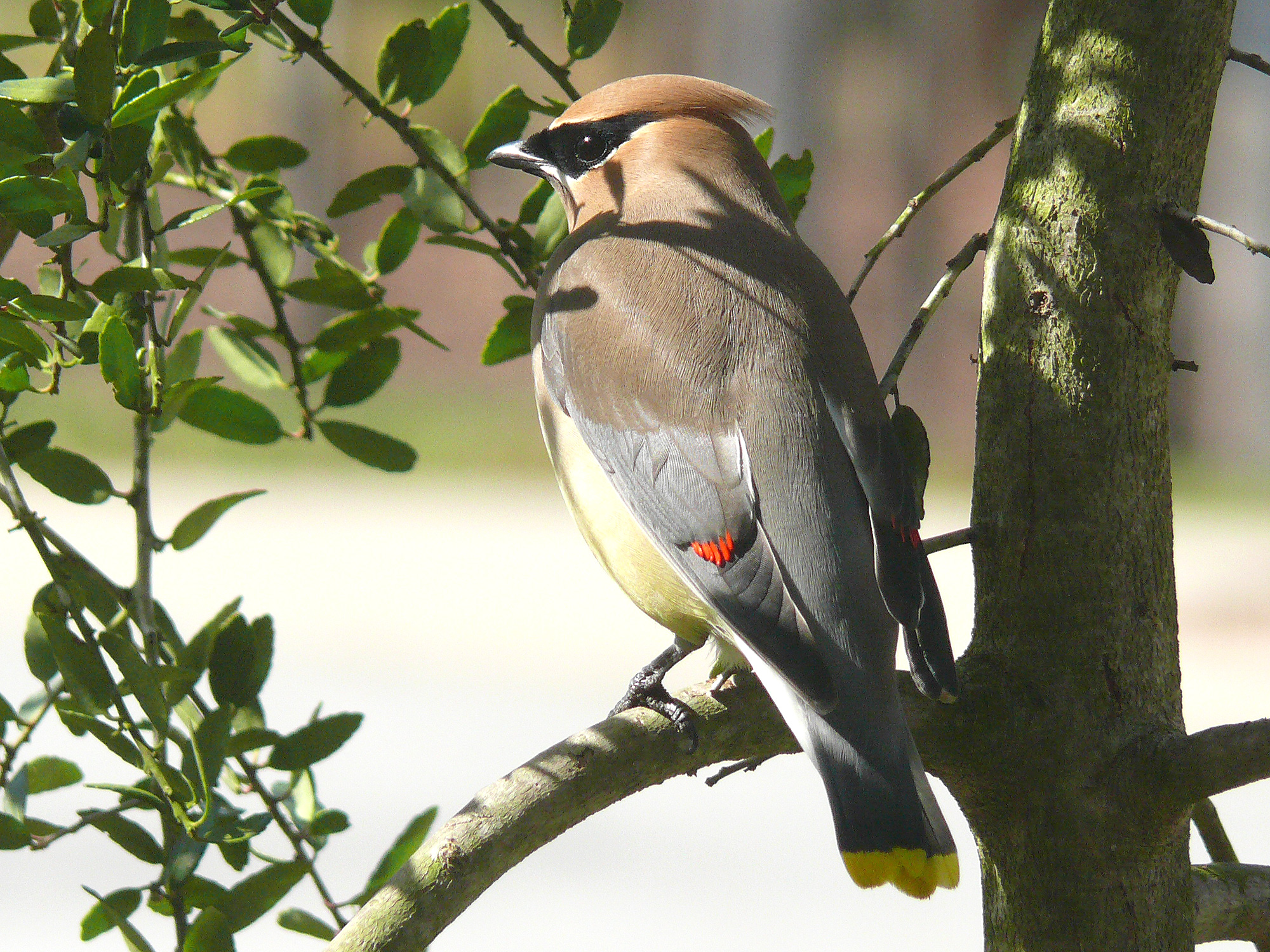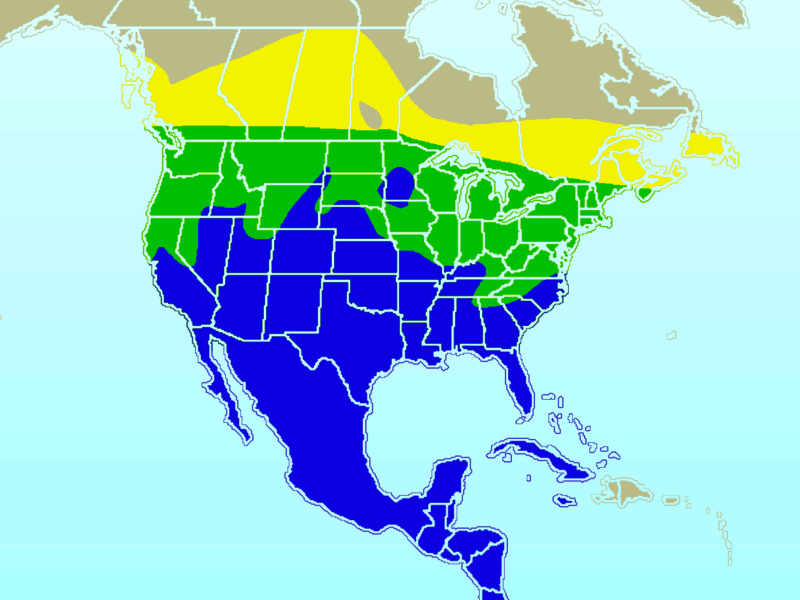- Cedar Waxwing
Taxobox
name = Cedar Waxwing
status = LC | status_system = IUCN3.1

image_width = 240px
regnum =Animal ia
phylum = Chordata
classis = Aves
ordo =Passeriformes
familia =Bombycillidae
genus = "Bombycilla "
species = "B. cedrorum"
binomial = "Bombycilla cedrorum"
binomial_authority = Vieillot,1808
range_
range_map_width = 240px
synonyms ="Ampelis cedrorum"The Cedar Waxwing ("Bombycilla cedrorum") is a member of the family Bombycillidae or waxwing family of
passerine birds. It breeds in open wooded areas inNorth America , principally southernCanada and thenorthern United States .Description
Cedar waxwings are approximately 6-7" (15-18 cm) in length and weigh roughly 30 grams. They are smaller and more brown than their close relative, the
Bohemian Waxwing (which breeds further to the north and west).These birds' most prominent feature is a small cluster of bright red feathers on the wings, a feature they share with the
Bohemian Waxwing (but not theJapanese Waxwing ). The tail is typically yellow or orange depending on diet. Birds that have fed on berries of introducedEurasia nhoneysuckle s while growing tail feathers will have darker orange-tipped tail-feathers. Adults have a pale yellow belly. Immature birds are streaked on the throat and flanks, and often do not have the black mask of the adults.During courtship the male and female will sit together and pass small objects back and forth, such as flower petals or an insect. Mating pairs will sometimes rub their bills together affectionately.
The flight of waxwings is strong and direct, and the movement of the flock in flight resembles that of a flock of small pale
European Starling s.Vocalizations
The calls of these birds include very high-pitched whistles and buzzy trills often represented as "see" or "sree".
easonal movements
Outside the breedings season, Cedar Waxwings often feed in large flocks numbering hundreds of birds. This species is irruptive, with erratic winter movements, though most of the population migrates further south into the
United States and beyond, sometimes reaching as far as northernSouth America . They will move in huge numbers if berry supplies are low. Rare vagrants have reachedwestern Europe , and there are two recorded occurrences of Cedar Waxwing sightings inGreat Britain . Individual Bohemian Waxwings will occasionally join large winter flocks of Cedar Waxwings.Birds in winter can be very confiding and will come into
garden s for berry bushes and trees and to splash and drink from fountains or bird baths.Diet
The Cedar Waxwing eats berries and sugary
fruit year-round, withinsect s becoming an important part of the diet in the breeding season. Its fondness for the small cones of the Eastern Redcedar (a kind ofjuniper ) gave this bird its common name.When the end of a twig holds a supply of berries that only one bird at a time can reach, members of a flock may line up along the twig and pass berries beak to beak down the line so that each bird gets a chance to eat.
Habitat
Preferred habitat consists of trees at the edge of wooded areas, or "open" forests, especially those that provide access to berry sources as well as water. Waxwings are attracted to the sound of running water, and love to bathe and drink from shallow creeks. In urban or suburban environments, waxwings often favor parkland with well-spaced trees, golf courses, cemeteries, or other landscaping with well-spaced trees, bushes that provide berries, and a water source, including fountains or birdbaths, is always a big plus.
Nesting
The nest is a loose open cup built with grass and twigs, lined with softer materials and supported by a tree branch averaging 2 to 6 meters above ground but, at times, considerably higher. The outer diameter of the nest is approximately 12cm to 16cm.
During courtship, the pair may pass a flower petal or insect back and forth repeatedly. Usually 5 or 6 eggs are laid and the female incubates them for 12 to 16 days. The eggs are oval shaped with a smooth surface and very little, if any, gloss. The egg shells are of various shades of light or bluish grey with irregular, dark brown spots or greyish-brown splotches. Both parents build the nest and feed the young. Typically, there are two broods during the mating season. Young leave the nest about 14 to 18 days after hatching.
Cedar Waxwings are also known as the Southern Waxwing, Canada Robin, Cedar Bird, Cherry Bird, or Recellet.
Cedar Waxwings in literature and law
According to experts on the writing of
Vladimir Nabokov , this species almost certainly inspired the waxwing mentioned prominently in his novel "Pale Fire ".Waxwings are protected by law in the US and may not be kept in captivity.
Links
* [http://www.mbr-pwrc.usgs.gov/id/framlst/Printversion/fs6190.html United States Geological Survey general info on cedar waxwings]
* [http://www.mbr-pwrc.usgs.gov/bbs/htm96/map617/ra6190.html USGS summer (breeding) map for cedar waxwings]
* [http://www.mbr-pwrc.usgs.gov/bbs/htm96/cbc622/ra6190.html USGS winter distribution map for cedar waxwings]
* [http://www.wordwiz72.com/waxwing.html General info, including photos and videos, with specific sites for finding cedar waxwings in San Diego County, California]
* [http://www.sdakotabirds.com/species/cedar_waxwing_info.htm South Dakota Birds - Cedar Waxwing Information and Photos]
* [http://www.bird-stamps.org/cspecies/13100200.htm Stamps]
* [http://ibc.hbw.com/ibc/phtml/especie.phtml?idEspecie=5697 Cedar Waxwing videos] on the Internet Bird CollectionReferences
* Witmer, Mark C., Mountjoy, D. James, and Elliot, Lang. "Cedar Waxwing (Bombycilla Cedrorum)." in The Birds of North America, Number 309 (Alan Poole and Frank Gill, editors.) The Academy of Natural Sciences, Philadelphia, PA, and The American Ornithologists' Union, Washington, D.C. 1997.
* Tyler, W.M. "Bombycilla Cedrorum: Cedar Waxwing" in Life Histories of North American Wagtails, Shrikes, Vireos and Their Allies. (Arthur Cleveland Bent, editor.) New York: Dover Publications: 1965 (Unedited reprint of: U.S. Government Printing Office: Smithsonian Institution United States National Museaum, Bulletin 197: 1950). pp.79-102
* Bent, Arthur Cleveland, editor. "Bombycilla Garrulus: Bohemian Waxwing" in Life Histories of North American Wagtails, Shrikes, Vireos and Their Allies. New York: Dover Publications: 1965 (Unedited reprint of: U.S. Government Printing Office: Smithsonian Institution United States National Museaum, Bulletin 197: 1950). pp.62-79.
* Stokes, Donald & Lillian. Guide to Bird Behavior, Volume 2. New York: Little, Brown &Company. 1983. (Cedar Waxwing, pp. 177-188)
* Sibley, David Allen. National Audubon Society: The Sibley Guide to Birds. New York: Alfred A. Knopf. 2000. (Waxwings: pp. 423.)
* Sibley, David, et. al, editors. National Audubon Society: The Sibley Guide to Bird Life & Behavior. New York: Alfred A. Knopf. 2001. (Waxwings: pp. 485-487; waxwing article by Mark Witmer.)
* Martin, Alfred G. Hand-Taming Wild Birds at the Feeder. Brattleboro, VT: Alan C. Hood & Company. 1963. (Waxwings: pp 113-117)
* Leister, Mary. "Cedar Waxwings: Unpredictable Birds." BirdWatcher's Digest. November/December 1991 (Vol 14, No. 2). pp. 50-55.
* Iliff, Marshall J. "Identify Yourself: Waxwings -- Cedar versus Bohemian." BirdWatcher's Digest. October 2001 (Vol 24, No. 1). pp. 38-42.
* Database entry includes justification for why this species is of least concern
* Stiles and Skutch, "A guide to the birds of Costa Rica" ISBN 0-8014-9600-4
Wikimedia Foundation. 2010.
